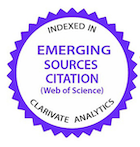Programa de erradicação de febre aftosa no estado de São Paulo: avaliação de dados oficiais obtidos entre 1997-2012
DOI:
https://doi.org/10.1590/1089-6891v18e-40675Palavras-chave:
Sanidade AnimalResumo
A Febre Aftosa (FA), doença altamente contagiosa que afeta os animais biungulados, é reconhecida pelos prejuízos econômicos nas propriedades e nas regiões onde é endêmica. O Estado de São Paulo não registra focos de FA desde 1996. A partir de dados oficiais obtidos de 1997 a 2012, este estudo organizou, analisou e confrontou as seguintes informações com a literatura pertinente: a) as taxas de vacinação contra FA de 1997 a 2012 no Estado de São Paulo; b) os resultados do monitoramento oficial delineado para demonstrar a eficiência da vacinação contra a FA; c) os procedimentos de vigilância passiva e de atendimento às notificações de suspeitas de doenças vesiculares no Estado de São Paulo; d) os resultados do monitoramento oficial delineado para demonstrar a ausência de circulação viral no Estado de São Paulo; e) a relação entre as medidas preventivas adotadas pelo serviço veterinário oficial diante de focos de FA em outros Estados limítrofes. Finalmente, foram descritas as perspectivas de implementação de área livre sem vacinação para o Estado de São Paulo, classificação outorgada pela Organização Mundial de Saúde Animal (OIE). A análise dos dados demonstrou que as medidas, estratégias e métodos de avaliação do programa de erradicação da FA aplicadas no Estado São Paulo foram eficientes para o objetivo a que se propõem. Apesar dos pontos analisados apresentarem-se favoráveis à mudança de classificação do Estado de São Paulo para área livre de FA sem vacinação, outros aspectos deverão ser verificados, como a estrutura do Serviço Veterinário Oficial estadual, o nível de controle de Estados com vínculo epidemiológico com o Estado de São Paulo e o comprometimento de toda a cadeia produtiva com a vigilância da FA.Palavras-chave: animais biungulados; doença vesicular; programa sanitário animal; vacinação.
Downloads
Não há dados estatísticos.
Downloads
Publicado
2017-06-02
Como Citar
RODRIGUES, Acácio Romualdo Assoni; OLIVEIRA, Luís Guilherme de; GATTO, Igor Renan Honorato; ALMEIDA, Henrique Meiroz de Souza; ROSSI, Gabriel Augusto Marques; MECHLER, Marina Lopes; SAMARA, Samir Issa. Programa de erradicação de febre aftosa no estado de São Paulo: avaliação de dados oficiais obtidos entre 1997-2012. Ciência Animal Brasileira / Brazilian Animal Science, Goiânia, v. 18, 2017. DOI: 10.1590/1089-6891v18e-40675. Disponível em: https://revistas.ufg.br/vet/article/view/e-40675. Acesso em: 24 dez. 2025.
Edição
Seção
MEDICINA VETERINÁRIA
Licença
Copyright (c) 2017 Ciência Animal Brasileira

Este trabalho está licenciado sob uma licença Creative Commons Attribution 4.0 International License.
Autores que publicam nesta revista concordam com os seguintes termos:
- Autores mantém os direitos autorais e concedem à revista o direito de primeira publicação, com o trabalho simultaneamente licenciado sob a Licença Creative Commons Attribution que permite o compartilhamento do trabalho com reconhecimento da autoria e publicação inicial nesta revista.
- Autores têm autorização para assumir contratos adicionais separadamente, para distribuição não-exclusiva da versão do trabalho publicada nesta revista (ex.: publicar em repositório institucional ou como capítulo de livro), com reconhecimento de autoria e publicação inicial nesta revista.
- Autores têm permissão e são estimulados a publicar e distribuir seu trabalho online (ex.: em repositórios institucionais ou na sua página pessoal) a qualquer ponto antes ou durante o processo editorial, já que isso pode gerar alterações produtivas, bem como aumentar o impacto e a citação do trabalho publicado (Veja O Efeito do Acesso Livre).






























